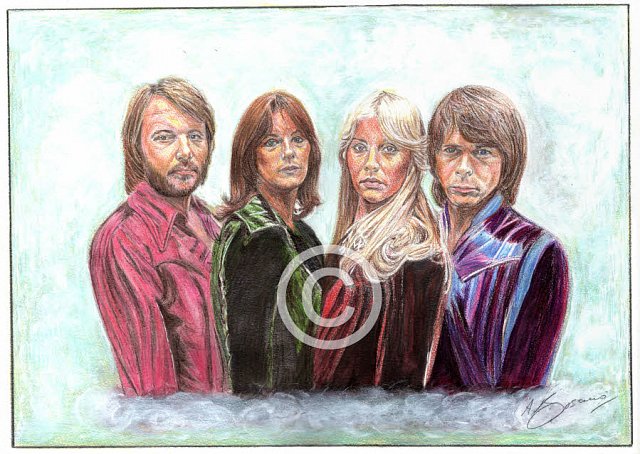ABBA
Pencil Portrait by Antonio Bosano.

Shopping Basket
The quality of the prints are at a much higher level compared to the image shown on the left.
Order
A2 Pencil Print-Price £35.00-Purchase
*Limited edition run of 250 prints only*
All Pencil Prints are printed on the finest Bockingford Somerset Velvet 255 gsm paper.
P&P is not included in the above prices.

Recommended listening
Abba Gold - Greatest Hits (1982)
Arrival (1976)
Abba- The Album (1977)
Voulez-Vous (1979)
The Visitors (1981)
Recommended viewing
ABBA - the Definitive Collection (1992)
Updated twenty years later in a remastered 16:9 format – that’s right, you get “more picture” but black bars either side of your screen – opinions remain divided on whether the “Essential Collection” exercise was worth it. Whatever your choice of aspect ratio – 16:9 vs 4:3 – both collections provide a fascinating audio-visual timeline of the group’s promo videos.
Pre-dating the MTV era, and drawing on The Beatles’ innovative use of the medium as a tool for worldwide promotion, ABBA would grasp the technological baton, deftly sidestepping a constant touring schedule in favour of studio time.
Anoraks might disagree, but it’s essentially all here – those early studio bound lip synced shorts, the more adventurous location based videos, the final post-production mini extravaganzas – the collection even boasting some of the rarer foreign language promos. If ABBA’s early efforts look a little primitive compared to big-budget modern music promos, the songs themselves now sound even better than ever, having been digitally re-mastered in 24-bit format. As well as featuring the digitally re-mastered promos for the majority of their single releases, exclusive previously unreleased material is also incorporated here, such as the extended original mix of “On and On and On.”
ABBA—The Definitive Collection, is value for money, squeezing in all 30 videos, plus five bonus tracks which include the promos for the Spanish-language versions of_ “I Have a Dream”, “Happy New Year”_ and “When All is Said and Done.” The video for the never released “When I Kissed the Teacher” is also included, too, as is a camp recording of “Dancing Queen” filmed at a gala tribute for Sweden’s King and Queen. If you can prize yourself away from Agnetha’s backside, there’s a 20-minute picture gallery, and an accompanying biographical booklet to enhance the visual experience.
Recommended reading
Bright Lights, Dark Shadows: The Real Story of Abba - (Carl Magnus) 2001 9Updated 2014)
Don’t bother purchasing in the expectation of a “kiss and tell” biography, nor some “whiter than white” hagiography.
Nevertheless, the ABBA members were all conservative, white, suburban, heterosexual people in their late 20s and early 30s who were married to each other. Eventually the marriages ended, both men quickly finding new partners, and there were a few inevitably dodgy business deals, but that was about as bad as it got. The details of their lives, especially during the group’s active years, were quite open.
As with The Beatles, ABBA served their apprenticeship and spared the world their earliest songwriting efforts. What they wanted to be was something new in pop – the companionable singalongs of Schlager allied to meticulous songwriting and a giant ‘Wall of Sound’ production drawn from the visionary American producer Phil Spector, the Beach Boys and the English-speaking pop tradition. Detail would be everything, and key to ABBA’s success was studio engineer Michael Tretow who created a form of double-tracking which duplicated the instruments and made the band sound enormous. Abba didn’t just have better songs. They sounded like nothing we’d heard before.


Comments
Be in no doubt that Neil McCormick is not an admirer of Sweden’s best selling export since the Volvo car. Commenting in “The Daily Telegraph” in 2008 on the eve of “Mamma Mia” premiering on the big screen, he was moved to write:
“I hate Abba. I hated them first time around, when their cheesy disco pop with its clod-hopping rhythms and banal, repetitive, linguistically challenged choruses made them singalong family favourites. And I hate them even more now, when the flattening effect of nostalgia has lent a spurious retro-credibility to their formulaic Euro drivel.”
“People talk about Abba as if they were on a par with The Beatles, when all they did was grab one little corner of the Fab Four’s harmonic oeuvre and pillage it for all it was worth. Sure, Björn Ulvaeus and Benny Andersson knew how to craft a pop song. The verses are catchy, the bridges prepare us for lift-off, the choruses are relentless and everything falls neatly in the right place. But they were musical one-trick ponies: the Ramones for squares, a spandex Status Quo. Just because they created hook-lines so insistent it would take invasive surgery to remove them from your cranium does not make them classic songwriters.”
Well I’ve always sort of liked them. I’ve seen the film, the stage show, and would never dream of turning them off when they’re on the radio. And unlike some mean spirited journalists, I always liked Agnetha’s backside. Inviting maybe, but fat? Never! But the thing is – I’ve never bought one of their discs and I’d never, ever, go out of my way to consciously put them on a CD machine. So for me, they fall into some sort of musical limbo land. Why? That’s that’s not an easy question to answer, although one can start with those early outfits. Looking like they’d been kicked off the set of “Star Trek” never bode well for establishing credibility with the N.M.E. Aah well……………
http://www.nclack.k12.or.us/cms/lib6/or01000992/centricity/domain/519/64301138.pdf